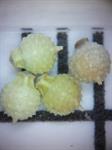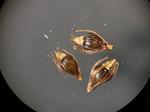Click the number at the start of a key lead to highlight both that lead and its corresponding lead. Click again to show only the two highlighted leads. Click a third time to return to the full key with the selected leads still highlighted.
1 Achene enclosed in a perigynium (a sac-like structure); [subfamily Caricoideae, tribe Cariceae] |
1 Achene not enclosed in a perigynium. |
..2 Scales obviously and strongly distichously imbricate; spikelets either aggregated into spikes or heads ( Cyperus, Dulichium, Schoenus), or solitary ( Abildgaardia); [subfamily Cyperoideae]. |
....3 Spikelets solitary and terminal (rarely 2-4); of FL peninsula in our area] |
....3 Spikelets aggregated into terminal or axillary spikes or heads; [widespread in our area]. |
......4 Inflorescence axillary; leaves predominantly cauline, conspicuously 3-ranked; perianth bristles subtending the achene 6-9; [tribe Dulichieae] |
......4 Inflorescence terminal, more-or-less scapose (though immediately subtended by leafy bracts); leaves predominantly basal, not 3-ranked; perianth bristles absent ( Cyperus) or present ( Schoenus); [tribe Cypereae]. |
........5 Perianth bristles present |
........5 Perianth bristles absent |
..2 Scales spirally imbricate; spikelets not usually aggregated. |
..........6 Achene (when ripe) bony and white; style base persistent on the summit of the achene, forming a differently-textured or differently-colored tubercle; spikelets all unisexual, the pistillate spikelets 1-flowered, the staminate spikelets several-flowered; [subfamily Sclerioideae, tribe Sclerieae] |
..........6 Achene mostly brown, black, or tan; style base either persistent as a differentiated tubercle ( Bulbostylis, Eleocharis, Rhynchospora) or not ( Cladium, Eriophorum, Fuirena, Isolepis, Cyperus, Schoenoplectus, Scirpus, Trichophorum); spikelets mostly or all bisexual; [subfamily Cyperoideae]. |
............ 7 Style base persistent as a differentiated tubercle (this small and inconspicuous in Bulbostylis and some spp. of Rhynchospora). |
............ ..8 Leaves consisting of bladeless sheaths; spikelet 1 per stem, terminal (very rarely proliferating and with > 1 spikelet); [tribe Eleocharideae] |
............ ..8 Leaves with well-developed blades; spikelets few to many per stem, usually subtended by foliaceous bracts. |
............ ....9 Perianth bristles absent; spikelets several-many-flowered; leaves capillary; [tribe Abildgaardieae] |
............ ....9 Perianth bristles present (rarely absent in species without capillary leaves); spikelets 1-2-flowered (several-many-flowered in some species without capillary leaves); leaves capillary to broad; [tribe Schoeneae] |
............ 7 Style base not persistent as a differentiated tubercle. |
............ ......10 Achene not subtended by a modified perianth of bristles or scales (in addition to the scales of the spikelets). |
............ ........11 Involucral bracts 1-3, the lowest erect, appearing like a continuation of the culm, the inflorescence therefore appearing lateral. |
............ ..........12 Achenes 0.5-0.7 mm long, 1.8-3× as long as wide, minutely papillose in longitudinal lines; [tribe Cypereae] |
............ ..........12 Achenes 1.2-1.5 mm long, 1-1.4× as long as wide, minutely pitted or transversely rugose. |
............ ............ 13 Achenes transversely rugose; [tribe Fuireneae] |
............ ............ 13 Achenes minutely pitted in longitudinal lines; [tribe Cypereae] |
............ ............ ..14 Spikelets in a loose cluster (not spherical) |
............ ............ ..14 Spikelets aggregated into spherical glomerules |
............ ........11 Involucral bracts 2-several, spreading, the inflorescence therefore appearing terminal. |
............ ............ ....15 Plants diminutive, to 5 dm tall; leaves 3-15 cm long, < 1 mm wide; [tribe Abildgaardieae] |
............ ............ ....15 Plants moderate to very robust, (3-) 5-30 dm tall; leaves 30-150 cm long, 1.5-15 mm wide. |
............ ............ ......16 Flowers 1-2 per spikelet; [tribe Schoeneae] |
............ ............ ......16 Flowers several-many per spikelet. |
............ ............ ........17 Style fimbriate; leaves 0.5-5 mm wide; [tribe Abildgaardieae] |
............ ............ ........17 Style smooth; leaves (2-) 5-18 mm wide; [tribe Scirpeae] |
............ ......10 Achene subtended by a modified perianth of either bristles, 3 stalked paddle-like scales, or 1-2 broad-based scales (in addition to the scales of the spikelets). |
............ ............ ..........18 Achene subtended by stalked paddle-like scales or broad-based scales. |
............ ............ ............ 19 Achene lacking a perianth, but subtended by 1-2 broad-based scales; plants 0.5-3 dm tall; [tribe Cypereae] |
............ ............ ............ 19 Achene subtended by a perianth of 3 stalked paddle-like scales; plants 2-7 dm tall; [tribe Fuireneae] |
............ ............ ..........18 Achene subtended by bristles. |
............ ............ ............ ..20 Bristles 10-many, > 5× as long as the achene, white to tawny, straight; [tribe Scirpeae] |
............ ............ ............ ..20 Bristles 1-6, usually < 4× as long as the achene, brown, straight or conspicuously twisted (twisted if > 3× as long as the achene). |
............ ............ ............ ....21 Involucral bracts lacking, or consisting only of the slightly modified basal scales of the solitary and terminal spikelet; [of hillsides, upland forests, or cliffs; never (in our area) in marshes, bogs, or streambeds]; [tribe Scirpeae] |
............ ............ ............ ....21 Involucral bracts present, consisting either of a single, erect bract appearing as a continuation of the culm (the inflorescence thus appearing lateral) or of 2 or more spreading, foliaceous bracts (the inflorescence thus appearing terminal); [of marshes, bogs, streambeds, ditches, or (rarely) terrestrial or on rock outcrops]. |
............ ............ ............ ......22 Main involucral bract 1 (rarely 2), erect, appearing as a continuation of the culm (the inflorescence thus appearing lateral, though in some species the longer inflorescence branches may overtop the bract); [tribe Fuireneae] |
............ ............ ............ ........23 Achenes rugulose; plants annual |
............ ............ ............ ........23 Achenes smooth; plants perennial |
............ ............ ............ ......22 Main involucral bracts 2-8, spreading and foliaceous (the inflorescence thus appearing terminal). |
............ ............ ............ ..........24 Spikelets 10-40 mm long, 6-12 mm in diameter, (1-) 2-40 (-50) per culm; [tribe Fuireneae] |
............ ............ ............ ..........24 Spikelets 2.5-19 mm long, 2-4 mm in diameter, usually > 50 per culm; [tribe Scirpeae] |
1 Bristles smooth, without teeth along the margins, strongly contorted and greatly exceeding the achenes when extended. |
..2 Scales usually with prominent green midribs; mature bristles mostly contained within the scales; achenes 1.0-1.3 mm long, brown to purplish-brown when mature. |
....3 Perianth bristles (extended) shorter than, equal to, or slightly exceeding the achene; mature culms lax, the inflorescences lopping over to (or nearly to) the ground, with 2-3 lateral inflorescences in addition to the terminal one; rays of the inflorescence scabrous throughout their lengths, ascending to divergent, with axillary bulblets |
....3 Perianth bristles (extended) exceeding the achene by 2-3×; mature culms rigid, nearly upright, with 0-2 lateral inflorescences in addition to the terminal one; rays of the inflorescence glabrous for most of their lengths (moderately scabrous toward outer end), ascending, lacking axillary bulblets |
..2 Scales usually with inconspicuous midribs; mature bristles exceeding the scales and giving the inflorescence a woolly appearance; achenes 0.6-1.0 mm long, whitish, pale, brown, dark brown or black. |
......4 Plants colonial by elongate rhizomes; scales 2-3.1 mm long; achenes reddish-brown; [NJ northwards] |
......4 Plants cespitose in tussocks; scales 1.1-2.2 mm long; achenes tan to whitish; [collectively widespread]. |
........5 Achenes maturing Aug-Sep; spikelets in dense cymes of 2-15, the central spikelet sessile, the others either sessile or pedicellate; [widespread] |
........5 Achenes maturing Jun-Jul; spikelets in open cymes, the central spikelet sessile, the others pedicellate; [NJ, PA, WV, OH, and KY northwards]. |
..........6 Achenes maturing late Jun to early Jul; scales usually blackish, at least toward the tip; involucral bracts solid black at base; leaves 2-5 mm wide; [WV northwards] |
..........6 Achenes maturing Jul; scales pale brown (rarely some black along the midrib); involucral bracts brownish at base (sometimes bordered with black); [n. NJ, OH, c. KY, and MO northward] |
1 Bristles with retrorse or antrorse teeth along the margins, strongly contorted to nearly straight, shorter than to greatly exceeding the achenes when extended (or bristles absent or nearly so in S. georgianus). |
............ 7 Spikelets all solitary with distinct pedicels; mature scales with broad green midribs; achenes with protruding angles and concave sides |
............ 7 Spikelets all or mostly in glomerules with the pedicels scarcely developed; mature scales with midribs not usually green; achenes less sharply trigonous, the sides convex, flat, or slightly concave. |
............ ..8 Culms with 10-20 leaves; spikelets broadly ovate; scales reddish-brown and, excluding the tips, about as wide as long |
............ ..8 Culms with 2-10 leaves; spikelets broadly ovate to narrowly ovate; scales brown or black and, excluding the tips, mostly longer than wide. |
............ ....9 Bristle teeth thick-walled and sharp-pointed, densely arranged almost to the base of the bristle. |
............ ......10 Plants cespitose with short, brownish rhizomes; leaf sheaths green throughout; scales broadest above the middle; achenes 0.6-0.8 mm wide |
............ ......10 Plants spreading with long, reddish rhizomes having conspicuous nodes and internodes; lower leaf sheaths red-tinged near their bases; scales usually broadest below the middle; achenes (0.6-) 0.8-1.0 mm wide. |
............ ........11 Styles 3-cleft; achenes trigonous, with poorly-developed receptacles from which the bristles readily detach; bristles (3-) 6; upper part of culm usually scabrous; [widespread] |
............ ........11 Styles 2 (-3)-cleft; achenes biconvex with well-developed receptacles with persistent bristles; bristles 4 (-5); upper part of culm usually smooth; [from NJ, WV, and KY northward] |
............ ....9 Bristle teeth thin-walled and with rounded tips, mostly restricted to the upper 2/3 of the bristle (or bristles absent or nearly so in S. georgianus). |
............ ..........12 Bristles 0-3, shorter than the achenes; teeth, if present, concentrated near the tips of the bristles |
............ ..........12 Bristles usually 5-6, shorter than to slightly longer than the achenes; teeth extending basally from the tips of all or at least some of the bristles. |
............ ............ 13 Scales 1.6-2.8 mm long, terminating in a flattened or terete awn 0.4-0.6 (1.2) mm long |
............ ............ 13 Scales 1.0-2.1 mm long, terminating in a mucro 0.1-0.3 (-0.4) mm long. |
............ ............ ..14 Mature culms lax and reclining with the inflorescences lopping over to (or nearly to) the ground; glomerules usually with < 15 spikelets; lower scales of spikelets slightly mucronate, blackish |
............ ............ ..14 Mature culms upright or nearly so; glomerules frequently with > 15 spikelets; lower scales of spikelets mucronate, blackish or brownish. |
............ ............ ....15 Lower leaf blades and sheaths usually nodose-septate; spikelets ovate or narrowly ovate; scales mostly brownish; longer bristles frequently exceeding the achenes; achenes 1.0-1.3 mm long |
............ ............ ....15 Lower leaf blades and sheaths nearly smooth; spikelets broadly ovate or ovate; scales mostly blackish; longer bristles usually shorter than or about equaling the achenes; achenes 0.8-1.1 mm long |





